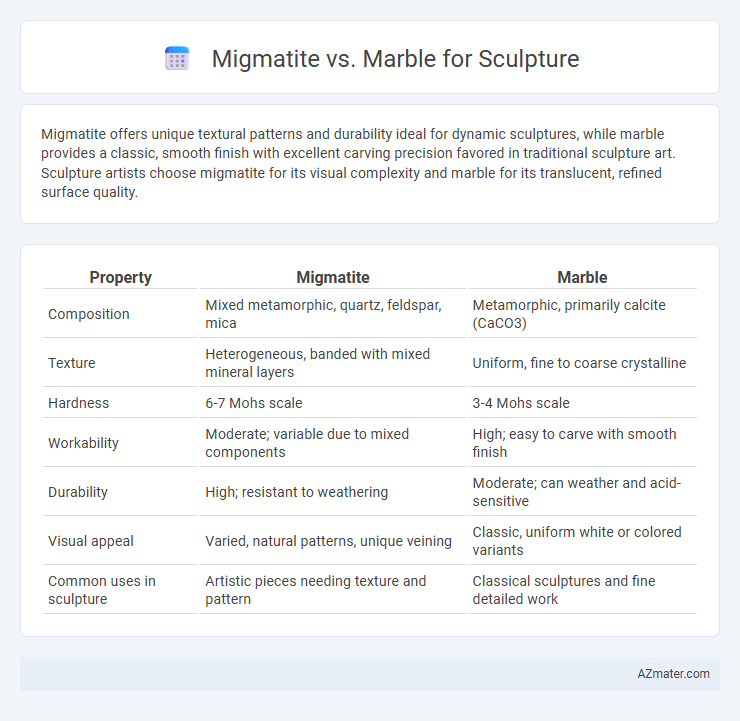Migmatite offers unique textural patterns and durability ideal for dynamic sculptures, while marble provides a classic, smooth finish with excellent carving precision favored in traditional sculpture art. Sculpture artists choose migmatite for its visual complexity and marble for its translucent, refined surface quality.
Table of Comparison
| Property | Migmatite | Marble |
|---|---|---|
| Composition | Mixed metamorphic, quartz, feldspar, mica | Metamorphic, primarily calcite (CaCO3) |
| Texture | Heterogeneous, banded with mixed mineral layers | Uniform, fine to coarse crystalline |
| Hardness | 6-7 Mohs scale | 3-4 Mohs scale |
| Workability | Moderate; variable due to mixed components | High; easy to carve with smooth finish |
| Durability | High; resistant to weathering | Moderate; can weather and acid-sensitive |
| Visual appeal | Varied, natural patterns, unique veining | Classic, uniform white or colored variants |
| Common uses in sculpture | Artistic pieces needing texture and pattern | Classical sculptures and fine detailed work |
Introduction to Migmatite and Marble in Sculpture
Migmatite, a mixed rock featuring both igneous and metamorphic characteristics, offers sculptors a unique blend of durability and texture, making it ideal for intricate and expressive sculptures. Marble, renowned for its fine grain and uniform composition, has been a preferred material in classical and contemporary sculpture due to its smooth surface and ability to capture detailed craftsmanship. Sculptors choose migmatite for its complex patterns and strength, while marble is favored for its elegance and ease of carving.
Geological Formation of Migmatite vs Marble
Migmatite forms through high-grade metamorphism involving partial melting of pre-existing rocks, resulting in a heterogeneous mixture of igneous and metamorphic components. Marble originates from the metamorphism of limestone or dolostone, characterized by recrystallization of calcite or dolomite crystals under heat and pressure. The complex, mixed composition of migmatite contrasts with the more uniform crystalline texture of marble, influencing their suitability and appearance in sculpture.
Physical Properties and Appearance Comparison
Migmatite exhibits a complex, banded appearance with alternating light and dark mineral layers, offering a unique contrast ideal for sculptures requiring intricate visual texture. Its physical properties include moderate hardness and durability, allowing for detailed carving while maintaining structural integrity. Marble, characterized by its crystalline, uniform texture and high calcite content, provides a smooth, polished finish and superior hardness, making it a preferred choice for classical sculptures demanding fine detail and a luminous surface.
Workability: Sculpting Techniques and Challenges
Migmatite offers a unique blend of metamorphic and igneous textures, presenting challenges in achieving fine-detail sculpting due to its heterogeneous composition and potential for uneven grain hardness. Marble, known for its consistent crystalline structure and relative softness on the Mohs scale (around 3), allows for smooth carving and fine finishes, making it favored for detailed sculpting techniques like chiseling and polishing. Sculptors working with migmatite must adapt techniques to manage variable fracturing and hardness, while marble enables precise tool control and a polished surface ideal for classical sculptures.
Durability and Weather Resistance
Migmatite exhibits superior durability and weather resistance compared to marble, making it an excellent choice for outdoor sculpture exposed to harsh environmental conditions. Its composite structure combines both metamorphic and igneous qualities, providing resilience against erosion, freeze-thaw cycles, and chemical weathering. Marble, while prized for its fine grain and aesthetic appeal, tends to be more susceptible to acid rain and surface degradation over time.
Aesthetic Appeal: Color, Texture, and Visual Impact
Migmatite offers a dynamic aesthetic appeal with its swirling patterns and variegated colors, combining light and dark mineral bands that create a striking visual contrast ideal for expressive sculptures. Marble, prized for its smooth texture and consistent coloration ranging from pure whites to subtle creams and soft pastels, delivers a classic and elegant look that highlights fine detail and form. Both materials provide unique visual impacts; migmatite's complex texture captivates with natural unpredictability, while marble's translucency and polish enhance light reflection, contributing to its timeless artistic allure.
Historical Use in Sculpture
Migmatite and marble have distinct historical significance in sculpture, with marble being the preferred material since classical antiquity due to its fine grain and ability to hold intricate details, exemplified by masterpieces from ancient Greece and the Renaissance. Migmatite, a metamorphic rock combining igneous and sedimentary features, is less commonly used historically in sculpture but valued in contemporary art for its unique, swirling patterns and durability. Marble's widespread use in iconic sculptures like Michelangelo's David contrasts with migmatite's niche application primarily in modern artistic expressions.
Cost and Availability for Artists
Migmatite is more expensive and less commonly available than marble, making it a costlier choice for sculptors. Marble offers widespread availability and a lower cost, providing artists with a more accessible material for detailed carving. The durability and aesthetic qualities of both materials impact their pricing and supply in the sculpture market.
Maintenance and Long-Term Care
Migmatite offers superior durability and resistance to weathering compared to marble, reducing maintenance requirements for sculptures exposed to outdoor elements. Marble, while prized for its fine grain and classic appearance, is more susceptible to acid rain and surface erosion, necessitating regular cleaning and sealing to preserve its details. Long-term care of migmatite sculptures typically involves less frequent intervention, making them advantageous for outdoor and public art installations with minimal upkeep.
Choosing the Ideal Stone for Your Sculpture
Migmatite offers unique, swirling patterns and exceptional durability, making it ideal for sculptures requiring intricate textures and resilience. Marble provides a smooth, homogeneous surface that is easier to carve finely and polishes to a high gloss, perfect for classical and detailed sculptures. Selecting between migmatite and marble depends on the desired aesthetic, workability, and long-term durability of the sculpture.

Infographic: Migmatite vs Marble for Sculpture
 azmater.com
azmater.com